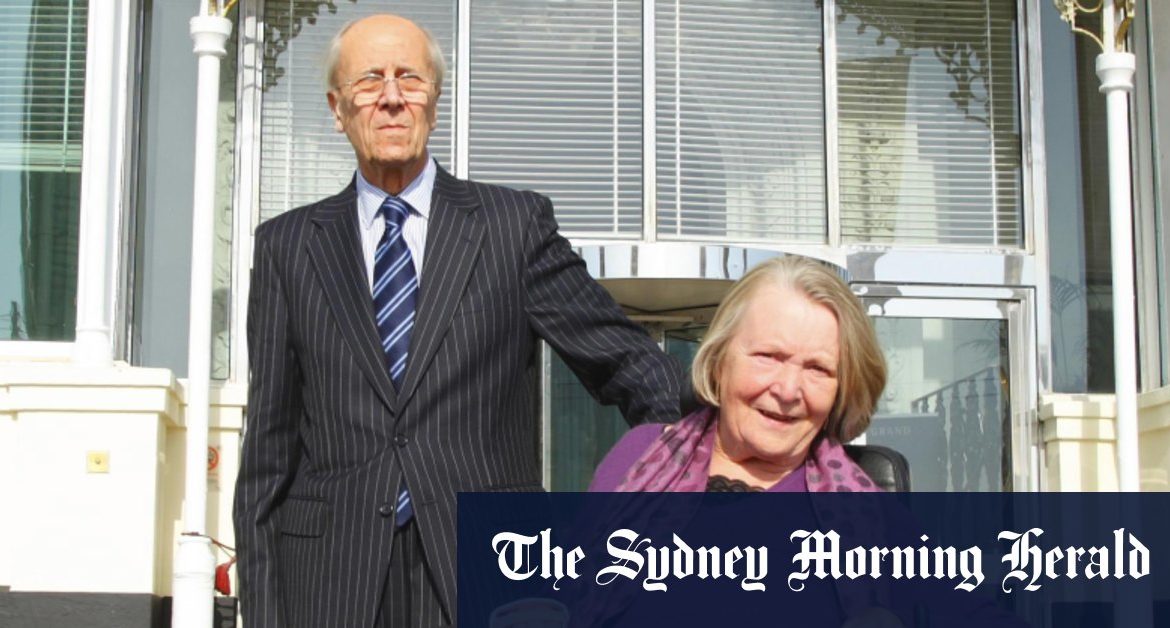Lord Tebbit and his wife Margaret stand outside the Grand Hotel in Brighton, East Sussex on the 25th anniversary of the bombing of the building by the IRA on October 12, 1984. Credit:Getty
At 2.54am on October 12, 1984, the last day of the conference, the Tebbits were in Room 228 on the sixth floor of the Grand when a bomb planted weeks before exploded above them. They plunged three storeys through choking dust and crashing masonry, landing amid the debris.
Working by lights from a television crew – the hotel’s power supply had failed – firemen extricated first Margaret Tebbit and then her husband, and they were taken to the Royal Sussex County Hospital.
It soon became clear that, while Norman Tebbit had suffered serious injuries to his chest and thigh and had broken a rib, his wife faced paralysis. When Mrs Thatcher – the bombers’ target – visited her in intensive care, Margaret Tebbit told her she had no feeling below the neck; as a former nurse, she knew what that meant.
In hospital, she saw people with similar injuries give up and die. She would later say: “What choice did I have? Die or cope.” She regained some feeling in her limbs, and after a fortnight was taken by helicopter to Stoke Mandeville Hospital.
Her husband stayed first at Chequers, then at RAF Halton, to be near her while recovering himself and getting back up to speed as a minister; he returned to the Commons after three months.
Her consultant, Dr John Silver, reckoned his best patients were the “bloody-minded ones”, and urged her to be just that. Giving a rare interview in 1992 to Terry Wogan, she said: “I have had the right people behind me, cursing me, swearing, encouraging me and bullying me. I clean my own teeth with an electric toothbrush and I can pick up a glass. When you have been paralysed from the neck down, you just have to hope you are going to achieve these things.”
She patiently worked on her recovery, despite having, as she told a radio presenter in 1995, a history of depression, eventually well managed by medication.
After the birth of her third child in 1965, she had become so ill that she was taken to hospital, and into the 1970s she suffered panic attacks when her husband was fighting an election. “It is a chemical reaction to things,” she said. “I could feel if I was ‘going off the rails’. ” In a way, that experience helped her to cope with the effects of the bomb.
The Tebbits’ marriage, joyful and rated one of the closest in politics, transcended their injuries. In Stoke Mandeville, Margaret Tebbit had visits from the Duke of Edinburgh, whom she told that she could now feel injections, and the Queen.
She began to learn how to control a wheelchair and use a computer. In March 1985, she was moved to a rehabilitation unit at the Nuffield Orthopaedic Centre, Oxford, then to the Radcliffe Infirmary.
That June, she made her first public appearance since the bombing, carried into the Royal Box at Wimbledon, and soon after was transferred to the Royal National Orthopaedic Hospital at Stanmore.
Margaret Tebbit hoped to appear at the Conservatives’ 1985 Blackpool conference, but her doctors advised against it. Two months later, though, she attended the Lord Mayor’s banquet at the Guildhall, receiving a standing ovation. Princess Diana and her infant sons laid on a tea party for the Tebbits at Kensington Palace; Prince William, then three, stroked Margaret’s hand.
In January 1987, she joined her husband in his Chingford constituency for the first time since the bombing. He was re-elected that June, but left the Cabinet saying: “I am not in a position to take over from the nurses, but she is looking forward to getting out and about more, and I would like to be able to enjoy a bit more of a family life.”
Frustrated at her difficulty in finding or keeping good carers – few lasted a year – in 1995 she launched an appeal for Aspire (the Association for Spinal Injury Research and Rehabilitation) to promote their training.
Norman Tebbit never moderated his contempt for the terrorists who had badly injured him, left his wife disabled and killed five other leading Tories. His wife was more measured, saying she could not forgive them unless they repented, and they had not.
She was born Margaret Elizabeth Daines at Ely on May 24, 1934, one of nine children of Stan Daines, a tenant farmer on the Fens, and his wife Elsie. She went to school in the town of March, leaving at 16 to work in London before training as a nurse.
While at St Bartholomew’s Hospital, she met Norman Tebbit, then an airline pilot, at a party; after a whirlwind courtship, they married in 1956. She gave up nursing, but until shortly before the bombing worked as a volunteer at Barts flower shop.
She is survived by her husband, their two sons and a daughter.
Most Viewed in National
Loading







